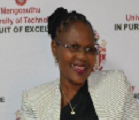Day 1 :
Keynote Forum
Zodwa Dlamini
Mangosuthu University of Technology, South Africa
Keynote: RBBP6 is a multifunctional gene in human cancers: Role in mitosis and carcinogenesis

Biography:
Zodwa Dlamini is Deputy Vice Chancellor; Research, Innovation & Engagements at Mangosuthu University of Technology and a Professor of Molecular and Functional Genomics. She was previously Deputy Executive Dean at UNISA. She is also the current Vice-Chairperson of the South African Medical Research Council Board. She completed her BSc and BSc Hons. in Biochemistry at University of Western Cape, MSc at University of Natal and PhD at University of Natal. Her research interests include the “Omics technologies including the use of bioinformatics to provide unprecedented possibilities to identify the underlying molecular basis of cancer”.
Abstract:
RBBP6 is an alternately spliced gene that gives rise to three unique splice variants with diverse biological functions. Its gene products have been demonstrated to play a role in cell cycle regulation, apoptosis and protein processing. RBBP6 homologues have been shown to be negative regulators of the guardian of cells, p53, linking it to tumourigenesis. We have shown that it is involved in lung carcinogenesis. We have also shown that RBBP6 isoform 3 is a regulator of G2/M cell cycle arrest. We aimed to explore the function of RBBP6 isoform 3 and its expression pattern in carcinogenesis. Cell cycle arresting agents, such as arsenic trioxide and cisplatin were used to arrest colon and cervical cells to study the role of the smallest RBBP6 isoform. The expression and cell distribution of RBBP6 were analysed using real-time PCR and western blotting and cell analysis flow cytometry, respectively. We used immunohistochemistry to establish the expression patterns of RBBP6 in colon and cervical cancer tissues. RBBP6 isoform 3 causes cell cycle arrest at G2/M and its diminished expression results in cell cycle progression. We have also shown that RBBP6 isoform 3 plays a role in cell cycle regulation and carcinogenesis in cervical and colon tissues. These studies have shown that RBBP6 isoform 3 has great potential as a therapeutic target for drug development.
Keynote Forum
Petr Sifta
Charles University in Praque, Czech Republic
Keynote: Comparison of Effects of various methods of Recovery of Muscle after applied Exercise

Biography:
Petr Sifta completed PhD from Faculty of Physical Education and Sport, Charles University in Prague and Post-graduate in Biomechanics during 2002-2005 and working in External cooperation with Technical University in Liberec, Faculty of mechanical engineering from 2008. He is a member of Czech Society of Kinesiology from 2008.
Abstract:
Recovery of muscle in athletes is often discussed topic in sport training. There is a great need to decrease the muscle tone in order to recover the muscle tissue. The most used techniques to improve recovery are massage, various techniques of stretching, cryotherapy, active recovery (light exercise), warm, sauna, hydrotherapy, food supplements, dry needling etc. The aim of the research is to find a method that speeds up a recovery of muscle tissue (in terms of rheology, viscosity and elasticity) and to prove, if the recovery of muscle tissue after applied aerobic exercise may be helped by any technics. Objective of the research is to evaluate and compare four types of recovery and find out which method is most efficient to improve recovery of triceps surae muscle after aerobic exercise. We suppose that muscle recovery can be represented by state of viscoelastic properties of muscle (stiffness and elasticity). We use myotonometry in order to measure the muscle tone before and after used special recovery technique.
- Biomedical engineering
Location: 2

Chair
Maytham Abdala Ali Al-Shanawa
University of Basra, Iraq

Co-Chair
Eric T Holt
University of Michigan, USA
Session Introduction
Eric T Holt
University of Michigan, USA
Title: Application of elevated pressures to cultures of the hydrogen-oxidizing bacteria, Cupriavidus necator

Biography:
Eric Holt is pursuing his PhD in Gulari Laboratory at University of Michigan. He completed his Master’s degree at University of Michigan and Bachelor’s at Univeristy of Louisville. Prior to pursuing an engineering degree, he served in United States Marine Corps. His interests are in “The development of clean and sustainable
processes by utilizing the capabilites of microorganisms”.
Abstract:
The use of pressure as a parameter to manipulate the growth and production of cell cultures has recently begun to be thoroughly investigated. The variability of effects on different cell types and species indicates that there is much more to learn about the use of elevated pressures (up to 10 bar) within bioreactors and how to best utilize this asset. During this talk, we will explore the current state of research on the applications of elevated pressures to bacterial cultures with specific consideration to its use in the culturing of hydrogen-oxidizing bacteria.

Biography:
Maytham Abdala Ali Al-Shanawa completed his PhD at Sheffield Hallam University (UK), under supervision of Professor Alexie Nabok in MERI. He has published
more than seven papers; and attended about nine global conferences in (UK, France, Croatia, Jordan and Iraq).
Abstract:
Environmental pollution can be defined as any discharge of material or energy into water, land and air, that causes adverse changes to the earth's ecological balance, or that lowers the quality of life. One of the most danger contaminations are the heavy metals, which are commonly referred to as trace metals; many trace metals are highly toxic to humans (e.g. Hg, Pb, Cd, Ni, As, Sn) and other living organisms in the environment. There are many techniques used for detection of heavy metals, for example; AAS, ICP-MS and Chromatography. In this project, the bio-cell sensor that included the microorganisms bacteria ( E. coli and D. radiodurans) was employed for detection of heavy metals, which is considered to be a cheap (cost effective), simple (easy to use), powerless (portable)
and sensitive technique. Characterization of bacteria samples were carried out using a variety of experimental techniques, i.e. optical methods including optical density measurements, UV-Vis spectrophotometer, fluorescent microscopy and spectroscopy for studying light scattering in bacteria samples and electrical methods both DC and AC are used. The results of the optical methods appeared
to be completely different of bacteria response and did not correlate with the (live/dead) bacteria ratio, which are due to the effect of (Cd2+, Ni2+) ions on light scattering. The electrical technique was used to study the effect of heavy metals (CaCl2 and CaCl2) on bacteria. The effect of metal salt appeared to be comparable on both E. coli and D. radiodurans bacteria. AC and DC properties of
electrochemical solutions that contained E. coli and D. radiodurans bacteria were studied, and the results were compared to and normalized to the results of samples not mixed with metals. Comparative figures can be used to estimate metal concentration and the effect of metal on bacteria.
Petr Sifta
Charles University in Praque, Czech Republic
Title: Tendo-deformational characteristic of soft tissue (muscle tissue) measured by myotonometer

Biography:
Petr Sifta completed PhD from Faculty of Physical Education and Sport, Charles University in Prague and Post-graduate in Biomechanics during 2002-2005 and working in External cooperation with Technical University in Liberec, Faculty of mechanical engineering from 2008. He is a member of Czech Society of Kinesiology
from 2008.
Abstract:
The purpose of the research described in this work is to answer how to measure the rheologic (viscoelastic) properties and tendo– deformational characteristics of soft tissue. The method would also deals with the resemblance of muscle palpation examination as it is known in clinical practice. For this purpose, an instrument with the working name “myotonometer” has been used. The Myotonometer measures constrain dislodging attributes of muscle and different tissues situated underneath the measuring test. At present, there is lack of objective methods for assessing the muscle tone by viscous and elastic properties of soft tissue. That is why we
decided to focus on creating or finding quantitative and qualitative methodology capable to specify muscle tone.
